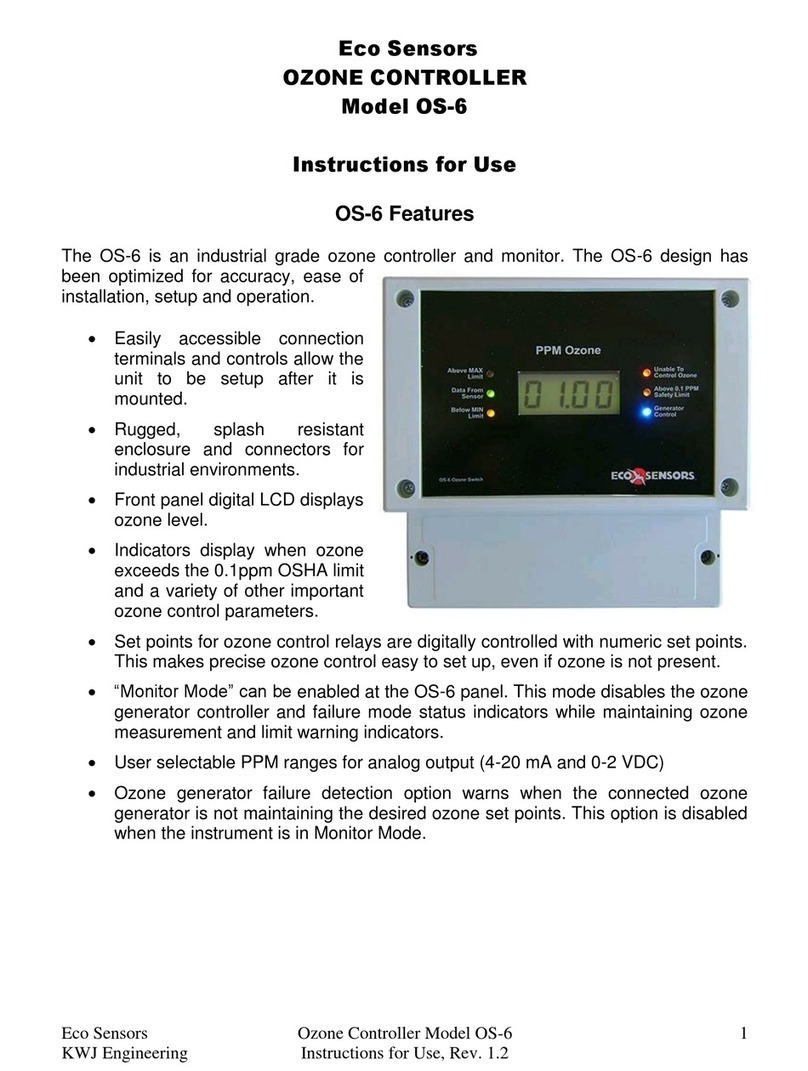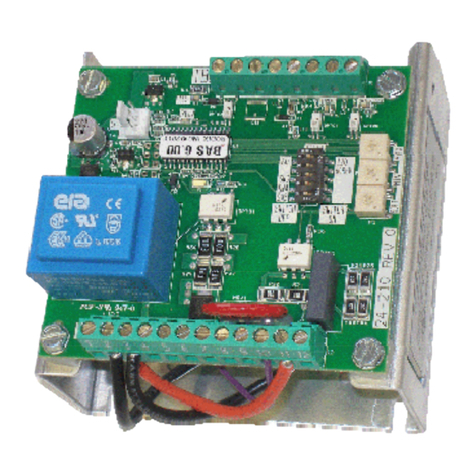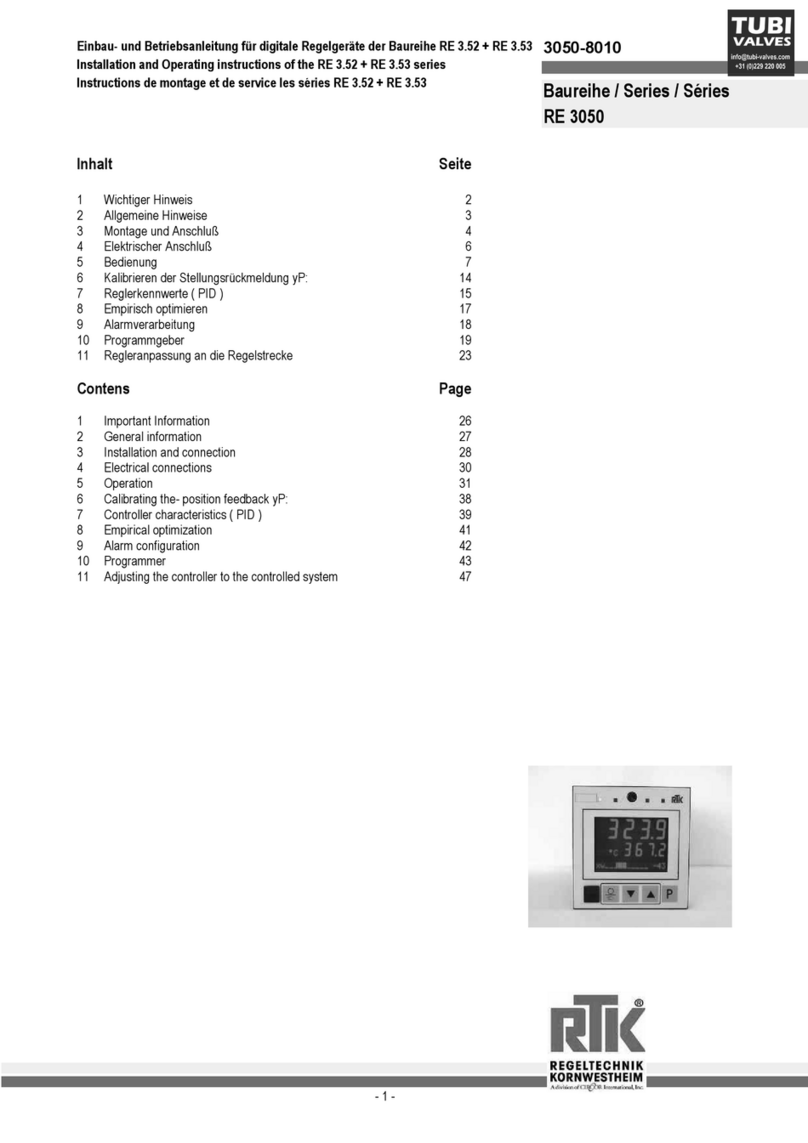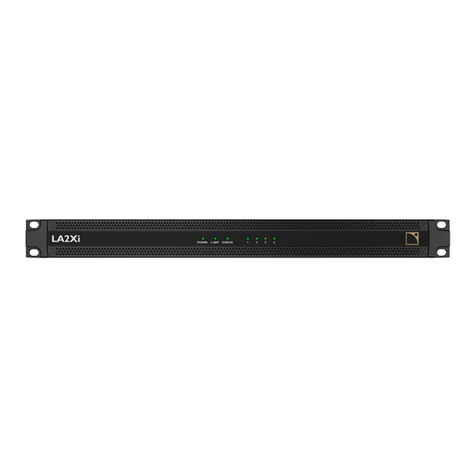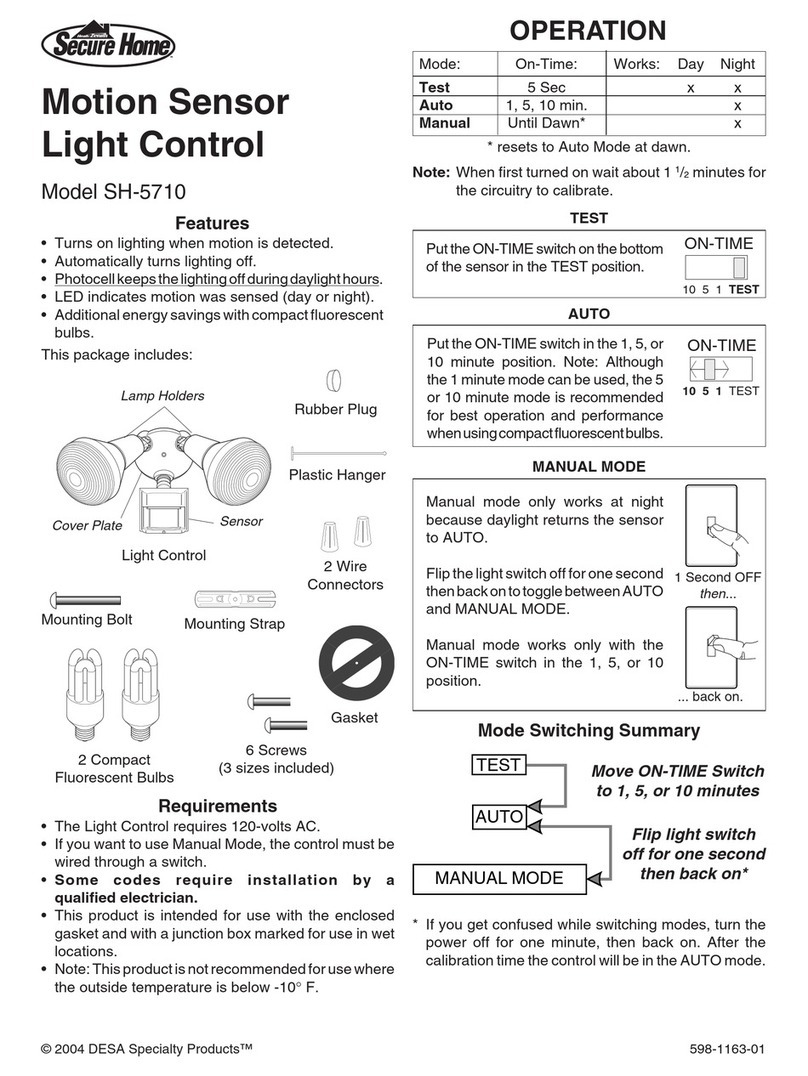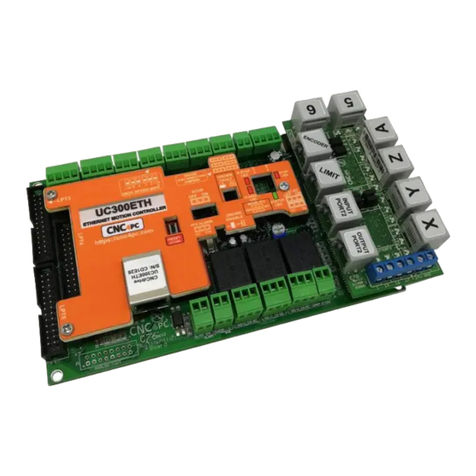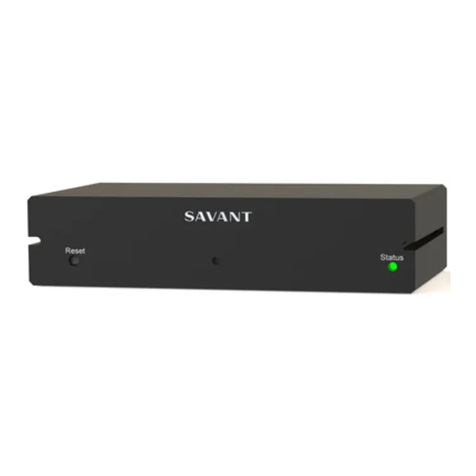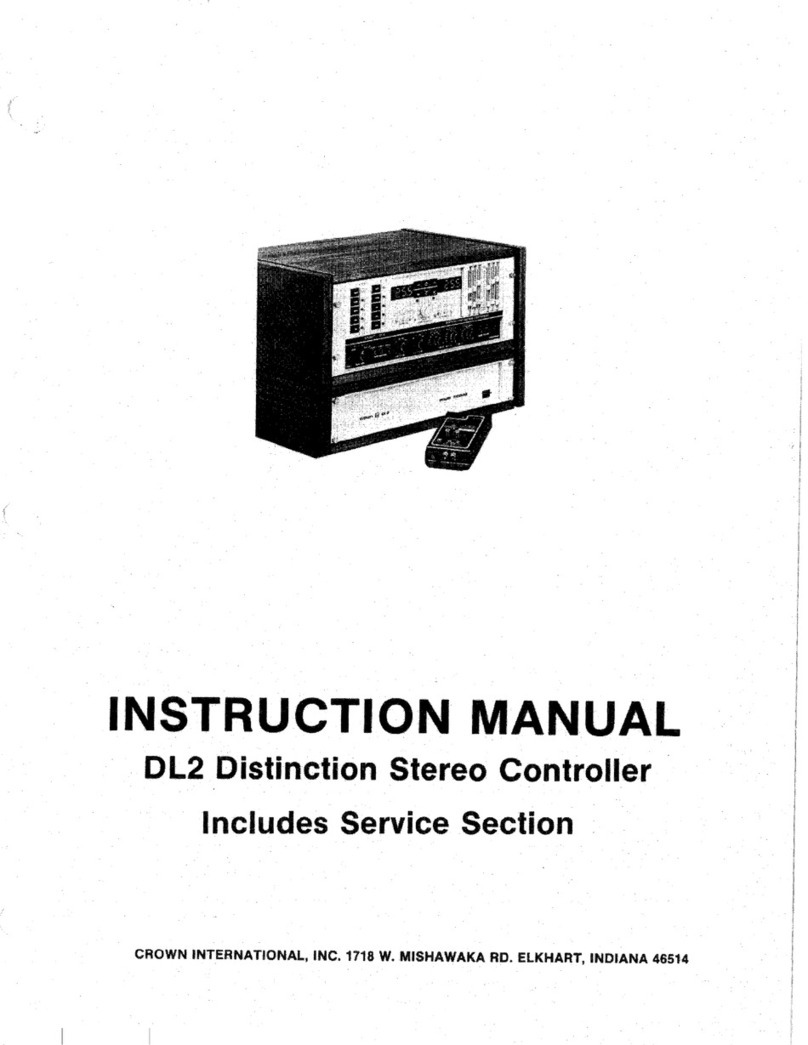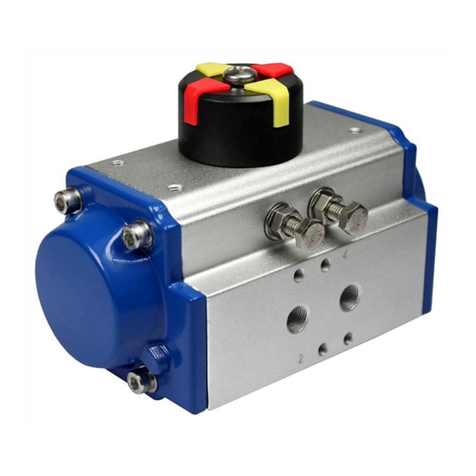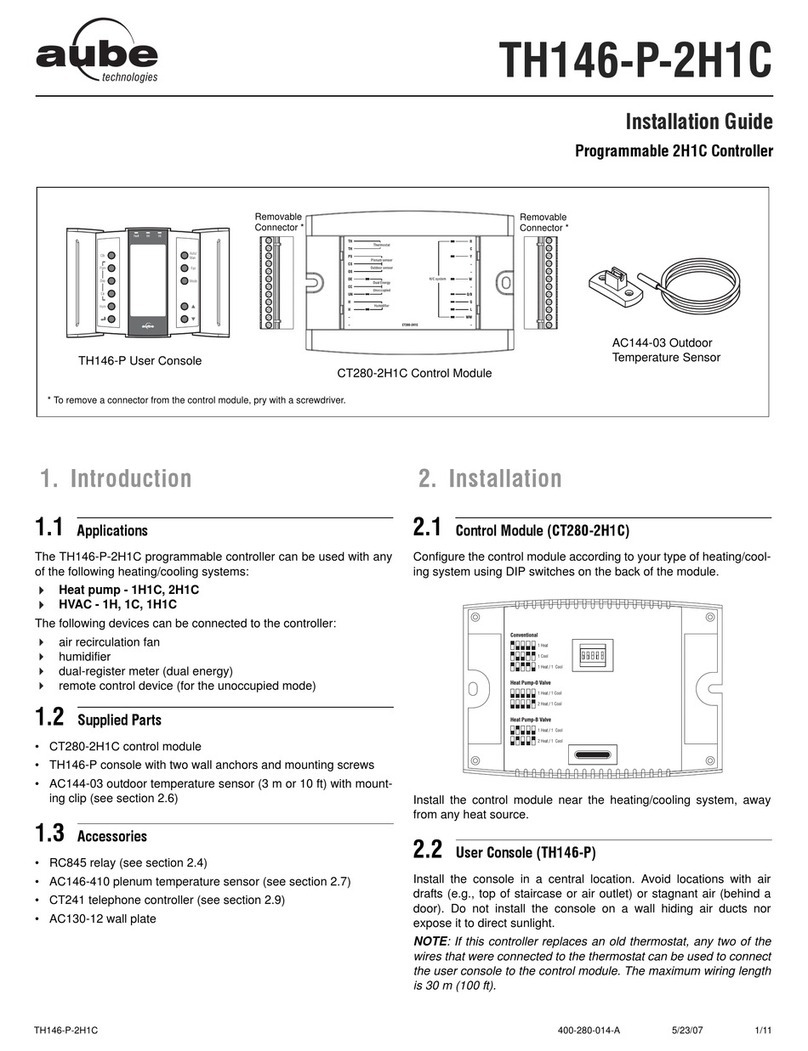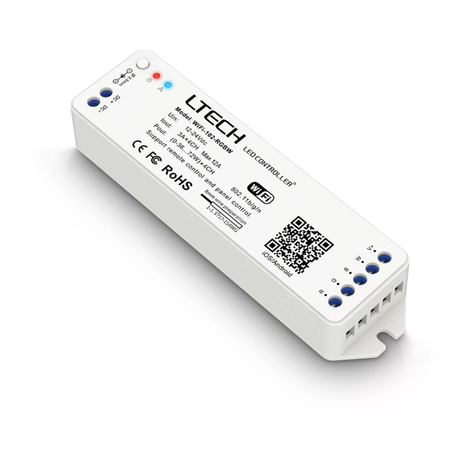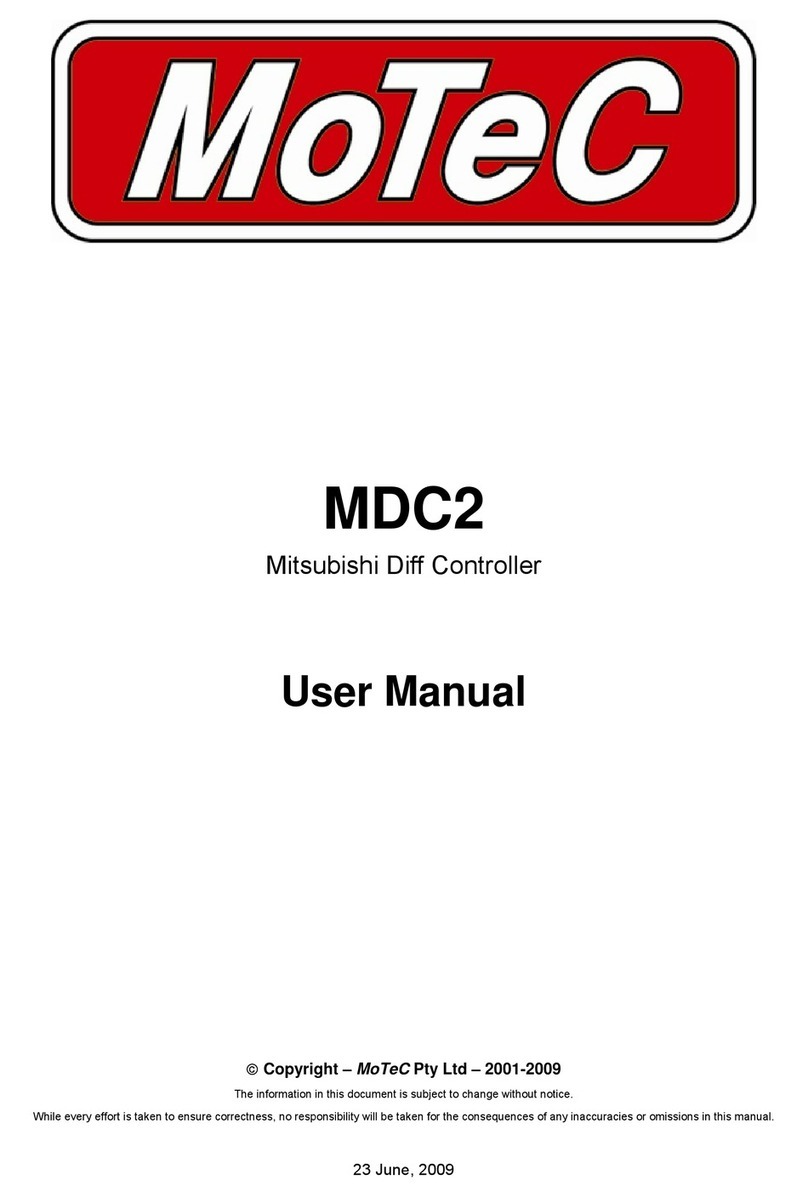ECO Sensors PAC-44 Series User manual

28
1
ECO SENSORS, INC.
PAC-44 SERIES PROGRAMMABLE
GAS DETECTION CONTROLLER
1451 Old Pecos Trail
Santa Fe, NM 87505-4737 USA
Ph: 800-472-6626 fx: 505-988-1315 www.ecosensors.com
INSTALLATION / OPERATION MANUAL
REV: D OCT-19-2002

2
27

26
7.9 SYSTEM PROGRAMMING - OTHER CODES
“3132” Toggle Relays: This code allows the user to toggle the system relays to
confirm activation of controlled devices without having to apply test gas on the
sensors to achieve the same. This is a locked function. To achieve this, first input
the software unlock code, then, input code “3132”. The display will indicate that the
relay is “off” and all the relay coil amber LEDs will be go out. Depress push-button
“2” to toggle relay-1. This can be confirmed by the audible “click” from the relay as
well as the amber relay coil LED going on and off as you depress “2”. Next, depress
“3” to scroll to the next relay and repeat the last step. Continue on to the last two
relays by repeating the last two steps or hold down “3” to scroll to the end.
Selection: “On or Off”
“1323” Unlock Code: This code is provided as a safe guard to help ensure that
the user reads this manual before proceeding with the modification of certain
key functions. The code functions that are locked, are so indicated in the
explanation under each code description. Simply enter “1323” then the code
for the function that is to be changed. The display will indicate “Unlocked”.
“3123” Reset System Defaults: This code allows the user to reset all the
programmed functions to the factory default settings. This can help if the user finds
themselves in a position where they may have “messed up” the programming and
cannot figure out how to get everything working properly again. To achieve this, first
input the software unlock code, then input code “3123”. Depress push-button “2 and
the display will indicate “finished” and the system will now be reset to factory
settings. Factory default settings are for a basic system with Carbon Monoxide sen-
sors.
8.0 REPLACEMENT PART NUMBERS
PART NUMBER DESCRIPTON
PAC-44-EN Fiberglass enclosure with Lexan label, audible alarm, silence
PAC-SPS Switching power supply
PAC-MCB Main circuit board
PAC-DDB LCD digital display board c/w ribbon cable
XXXX 90 Db audible alarm (door mounted)
XXXX Silence push-button (door mounted)
XXXX Top mounted, 4” diameter, red strobe light
Note: Consult factory for parts not listed above
RL 1 Menu 3132
Relay Ctrl Off
3
IMPORTANT NOTICE
READ AND UNDERSTAND THIS OPERATION MANUAL PRIOR TO USING
THIS INSTRUMENT.
THIS INSTRUMENT SHOULD BE INSPECTED AND PROGRAMMED BY
QUALIFIED AND TRAINED TECHNICIANS.
THIS INSTRUMENT HAS NOT BEEN DESIGNED TO BE INTRINSICALLY SAFE.
FOR YOUR SAFETY, DO NOT INSTALL IT IN CLASSIFIED HAZARDOUS
AREAS (EXPLOSION-RATED ENVIRONMENTS).
INSTRUMENT SERIAL NUMBER: _____________________________________
PURCHASE DATE: __________________________________________________
PURCHASED FROM: ________________________________________________
WARRANTY POLICY
ECO SENSORS, INC. WARRANTS THIS INSTRUMENT TO BE FREE FROM
DEFECTS IN MATERIALS AND WORKMANSHIP FOR A PERIOD OF TWO
YEARS FROM THE DATE OF PURCHASE. THE WARRANTY STATUS MAY BE
AFFECTED IF THE INSTRUMENT HAS NOT BEEN INSTALLED AND
MAINTAINED AS PER THE INSTRUCTIONS INDICATED IN THIS MANUAL
OR HAS BEEN ABUSED, DAMAGED OR MODIFIED IN ANY WAY. THIS
INSTRUMENT IS ONLY TO BE USED FOR PURPOSES STATED HEREIN. THE
MANUFACTURER IS NOT LIABLE FOR AUXILIARY INTERFACED EQUIP-
MENT OR CONSEQUENTIAL DAMAGE .
DUE TO ONGOING RESEARCH, DEVELOPMENT AND PRODUCT TESTING,
THE MANUFACTURER RESERVES THE RIGHT TO CHANGE SPECIFICATIONS
WITHOUT NOTICE. THE INFORMATION CONTAINED HEREIN IS BASED ON
DATA CONSIDERED ACCURATE. HOWEVER, NO WARRANTY IS EXPRESSED
OR IMPLIED REGARDING THE ACCURACY OF THIS DATA.
ALL GOODS MUST BE SHIPPED TO THE MANUFACTURER BY PREPAID
FREIGHT. ALL RETURNED GOODS MUST BE ACCOMPANIED BY AN RMA
NUMBER.

4
INDEX
SECTION DESCRIPTION PAGE
Notice and Warranty Policy 3
1.0 General 5
2.0 Specifications 5-6
3.0 Installation 6
3.1 Installation “Feet” Drawings 6
4.0 System Enclosure Exterior Dimensional Drawing 7
4.1 System Enclosure Interior Layout Drawing 8
4.2 Wiring 8-9
4.3 Wiring Terminals Strip Photos 9
4.4 Wiring Connections Drawing 10
5.0 Main Circuit Board Photo 11
6.0 System Operation 12-13
7.0 System Programming - General 14
7.1 System Programming - Input Codes 14
7.2 System Programming - Output Codes 15
7.3 System Programming - Analog Output Codes 15
7.4 Other Codes 15
7.5 Programming Push-Buttons Photo 16
7.6 System Programming - Input Code Description 16-20
7.7 System Programming - Relay Output Code Description 21-23
7.8 System Programming - Analog Output Code Description 24-25
7.9 System Programming - Other Codes 26
8.0 Replacement Parts 26
25
7.8 SYSTEM PROGRAMMING - ANALOG OUTPUT CODES, CONT’D…..
“1331” Calibrate Analog Output Low Limit: This code provides the user with a
method to calibrate the low limit for each analog output channel. An accurate digital
mulit-meter is required. First attach meter leads to channel-1 output terminal strip.
Set the meter to the DC mA scale. This is a locked function. To proceed, first input
the software unlock code. Next, input code “1331”. The voltage output will be
displayed on your digital multi-meter.
To calibrate this channel, depress push-button “3” to increment to “1” to decrement
the value to achieve “4.00” mA on your meter. Depress push-button “2” to scroll to
the next channel. Move only the positive meter lead to channel-2 and repeat the last
step to once again achieve a reading of 4.00 mA on your meter. Repeat the last two
steps for the last two channels, if they have been enabled for use. Once this function
is finished, continue to depress push-button “2” until you reach the last channel and
the system will automatically start to scroll through all “active” channels.
Selection: N/A
“1332” Calibrate Analog Output High Limit: This code provides the user with a
method to calibrate the high limit for each analog output channel. An accurate
digital mulit-meter is required. First attach meter leads to channel-1 output terminal
strip. Set the meter to the DC mA scale. This is a locked function. To proceed, first
input the software unlock code. Next, input code “1332”. The voltage output will be
displayed on your digital multi-meter.
To calibrate this channel, depress push-button “3” to increment to “1” to decrement
the value to achieve “20.00” mA on your meter. Depress push-button “2” to scroll to
the next channel. Move only the positive meter lead to channel-2 and repeat the last
step to once again achieve a reading of 20.00 mA on your meter. Repeat the last
two steps for the last two channels, if they have been enabled for use. Once this
function is finished, continue to depress push-button “2” until you reach the last
channel and the system will automatically start to scroll through all “active” channels.
Selection: N/A
AC 1 Menu 1331
Null
AC 1 Menu 1332
Span

24
7.8 SYSTEM PROGRAMMING - ANALOG OUTPUT CODES
“3231” Output Channel Enable or Disable: This code allows the user to enable or
disable any of the four system analog output channels. To achieve this, input code
“3231”, then depress push-button “3” for enable or “1” for disable. Depress push-
button “2” to scroll to the next channel. Once this function is finished, continue to
depress push-button “2” until you reach the last channel and the system will
automatically start to scroll through all “active” channels.
Selection: “Yes or No”
“3112” Monitor Input Channel: This code allows the user to select the input
channel each analog output channel will monitor. Each output can monitor only one
input channel. To achieve this, input code “3112”, then depress push-button “3” to
increment or “1” to decrement to the desired channel. Depress push-button “2” to
scroll to the next channel. Once this function is finished, continue to depress push-
button “2” until you reach the last channel and the system will automatically start to
scroll through all “active” channels.
Selection: “1, 2, 3 or 4”
“1321” Setting Analog Output Low Range: This code allows the user to select the
low range measurement for each channel. Default is 4.0 mA = “0”. This is a locked
function. To achieve this, first input the software unlock code, then input code
“1321”, then depress push-button “3” to increment or “1” to decrement the value.
Depress push-button “2” to scroll to the next channel. Once this function is finished,
continue to depress push-button “2” until you reach the last channel and the system
will automatically start to scroll through all “active” channels.
Selection: “0 to 1000”
“1322” Setting Analog Output High Range: This code allows the user to select
the high range measurement for each channel. Default is 20.0 mA = “full sensor
measurement scale”. This is a locked function. To achieve this, first input the
software unlock code, then input code “1322”, then depress push-button “3” to
increment or “1” to decrement the value. Depress push-button “2” to scroll to the
next channel. Once this function is finished, continue to depress push-button “2” until
you reach the last channel and the system will automatically start to scroll through all
“active” channels.
Selection: “ 0 to 10,000”
Note: Carbon Dioxide (CO2) is the only gas sensor type that provides a measure-
ment range selection from “0 to 50,000”.
AC 1 Menu 3231
Enabled ? Yes
AC 1 Menu 3112
Mon Channel 1
AC 1 Menu 1321
Range Low 0
AC 1 Menu 1322
Range High 200
5
1.0 GENERAL
The PAC-44 series systems are rugged, microprocessor based, programmable
controllers for use in non-hazardous (non-explosion rated) environments for
commercial and industrial applications. They can be configured for use with one to
four remote analog transmitters. They can also be configured with one integral
electrochemical sensor.
A standard system provides an LCD digital display, a common set of LED indicating
lights for fail, low, mid and high alarms, audible alarm with silence button, four
analog inputs, four analog outputs and four dry contact relays.
A large selection of “AST” series analog transmitters, utilizing electrochemical,
catalytic, infrared and MOS (Metal Oxide Semiconductor) sensor elements, are
available for use with this controller.
2.0 SPECIFICATIONS
Physical: a) Dimensions: 8.78” (223 mm) Wide X 10.5” (267 mm) High X
6.25” (159 mm) Deep
b) Weight: 6.33 pounds (2.87 kg)
Construction: Water/dust tight, corrosion resistant fiberglass with hinged,
secured door and Lexan door label
Power: 90 to 240 VAC, 47 to 63 Hz.
Current Load: Maximum allowable system current load is 1.36 Amps @ 24 VDC
Relays: Standard: Four only S.P.D.T. dry contact relays rated 5 amps @
240 VAC each
Output Signal: Linear, analog 4 - 20 mA or 0 - 10 VDC, jumper selectable
Visual: a) Common set of LED indicating lights for: Fault Alarm (red),
Low (Warning) Gas Alarm (amber), Mid Gas Alarm (red), High
Gas Alarm (red)
b) 16-character, two-line, back-lit LCD digital display
c) Amber colored, LED light, relay coil status indicators (internal)
d) Red colored, LED light “open loop” indicators for analog inputs
and analog outputs (internal)

6
1) PLASTIC MOUNTING
FOOT
2) SECURING BOLT
2.0 SPECIFICATIONS, CONT’D…..
Environment: a) Temperature: 0 deg. C. to + 40 deg. C (32 deg. F to 104 deg.
F.)
b) Humidity: 0 to 95% Rh
Fuses: System primary: Automatic resetting thermal fuse rated 1.5 amps
Switching power supply secondary: replaceable 2.0 amp
Certifications: CSA field inspected for low voltage safety
Options: a) Top mounted red strobe light (user programmable)
b) Water tight audible alarm & silence push-button
c) Top mounted audible alarm (103 dB horn)
d) Battery back-up system
e) Internal, programmable data logger
f) Internal sensor (one electrochemical toxic or Oxygen sensor)
3.0 INSTALLATION
Four removable mounting feet are supplied in a plastic bag inside the enclosure c/w
mounting bolts. These should be secured to the rear, outside corners of the
enclosure base. The mounting feet can be loosened off and rotated to two different
mounting positions, straight up vertically from the enclosure base or at a 45 degree
angle from the corner of the enclosure base.
For security, the PAC-44 controller should be installed inside a locked electrical,
mechanical or instrumentation room.
3.1 INSTALLATION “FEET” DRAWINGS
23
7.7 SYSTEM PROGRAMMING - RELAY OUTPUT CODES, CONT’D…..
“2321” Setting Relay Coil State: This code allows the user to select the normal
state of the relay in non-alarm condition (normally energized or normally
de-energized). To achieve this, input code “2321”, then depress push-button “3” to
increment or “1” to decrement through the choices. Depress push-button “2” to scroll
to the next channel. Once this function is finished, continue to depress push-button
“2” until you reach the last channel and the system will automatically start to scroll
through all “active” channels.
Selection: “Fail Safe-Yes or No”
Note: The definition of “Fail-Safe”, for the purposes of this manual, means to keep
the relay coil in a normally energized state in non-alarm condition.
“2313” Setting Relay Latching State: This code allows the user to select if one or
more of the system relays should “latch” when activated by a gas alarm or fault
alarm condition. Latching means that when the relay state changes because it was
activated by an alarm condition, it is held in this changed state. To achieve this,
input code “2313”, then depress push-button “3” to increment or “1” to decrement
through the choices. Depress push-button “2” to scroll to the next channel. Once this
function is finished, continue to depress push-button “2” until you reach the last
channel and the system will automatically start to scroll through all “active” channels.
Note: The user must depress and hold the acknowledge push-button for
approximately 10 seconds to release the latched relays.
Selection: “No or Yes”
“2333” Strobe Light Activation: The system circuit provides 24 VDC voltage
output to power a strobe light (see photo on page-9). This code allows the user to
select which alarm level activates the strobe light. The alarm level selected is
common to all channels. To achieve this, input code “2333”, then depress push-
button “3” to advance through the choices. Once this function is finished, depress
push-button “2” and the system will automatically start to scroll through all “active”
channels.
Note: Strobe always activates with all fault alarms.
Selection: “Low, Mid or High”
RL 1 Menu 2321
Fail Safe ? Yes
RL 1 Menu 2313
Latching ? No
ST 1 Menu 2333
Act Level Low

22
7.7 SYSTEM PROGRAMMING - RELAY OUTPUT CODES, CONT’D…..
“2332” Setting Relay Fault Activation: This code allows the user to assign one or
more relays to respond to fault alarm conditions. To achieve this, input code “2332”,
then depress push-button “3” to increment or “1” to decrement through the choices.
Depress push-button “2” to scroll to the next channel. Once this function is finished,
continue to depress push-button “2” until you reach the last channel and the system
will automatically start to scroll through all “active” channels.
Selection: “Zone, All, None, Sens”
“2112” Monitor Zone Number: This code allows the user to assign the zone
number the relay will monitor with regards to gas or fault alarms, if the input chan-
nels have been set up for “zone”. To achieve this, input code “2112”, then depress
push-button “3” to increment or “1” to decrement through the choices. Depress push-
button “2” to scroll to the next channel. Once this function is finished, continue to
depress push-button “2” until you reach the last channel and the system will
automatically start to scroll through all “active” channels.
Selection: “1, 2, 3 or 4”
“2113” Monitor Channel Number: This code allows the user to assign the channel
number the relay will monitor with regards to gas or fault alarms, if the input
channels have been set up for “zone”. To achieve this, input code “2113”, then
depress push-button “3” to increment or “1” to decrement through the choices.
Depress push-button “2” to scroll to the next channel. Once this function is finished,
continue to depress push-button “2” until you reach the last channel and the system
will automatically start to scroll through all “active” channels.
Selection: “1, 2, 3 or 4”
“2323” Setting Relay Alarm Level: This code allows the user to select the alarm
state to activate each relay. To achieve this, input code “2323”, then depress push-
button “3” to increment or “1” to decrement through the choices. Depress push-
button “2” to scroll to the next channel. Once this function is finished, continue to
depress push-button “2” until you reach the last channel and the system will
automatically start to scroll through all “active” channels.
Selection: “Low, Mid or High”
RL 1 Menu 2332
Fault Act All
RL 1 Menu 2112
Mon Zone 1
RL 1 Menu 2113
Mon Zone 1
RL 1 Menu 2323
Act Level Low
7
4.0 SYSTEM ENCLOSURE EXTERIOR DIMENSIONAL DRAWING

8
4.1 SYSTEM ENCLOSURE INTERIOR LAYOUT DRAWING
4.2 WIRING
Line voltage power to system: Take caution when drilling holes for installing
conduit connections to avoid damaging internal system components. An input
wiring terminal strip for line voltage (line and neutral) can be located at the top left
corner of the circuit board. A ground stud is located on the metal mounting plate
directly beside this terminal strip. Reference minimum and maximum system
voltage specifications on page-5 of this manual.
21
7.7 SYSTEM PROGRAMMING - RELAY OUTPUT CODES
“3221” Relay Enable or Disable: This code allows the user to enable or disable
any of the four system relays. To achieve this, input code “3221”, then depress
push-button “3” for enable or “1” for disable. Depress push-button “2” to scroll to the
next channel. Once this function is finished, continue to depress push-button “2” until
you reach the last channel and the system will automatically start to scroll through
all “active” channels.
Selection: “Yes or No”
“2311” Time Delay on “Make”: This code allows the user to set a time delay period
before one or more relays are activated in the event of a gas alarm. There is no time
delay available for a fault condition. To achieve this, input code “2311”, then depress
push-button “3” to increment or “1” to decrement the time. Once this function is
finished, continue to depress push-button “2” until you reach the last channel and
the system will automatically start to scroll through all “active” channels.
Note: A relay assigned to activate in the event of a gas alarm will activate
immediately unless an off delay is programmed. If an off time delay has been
programmed, the relay will deactivate after the off delay has expired.
Selection: “0.0 to 10.0” minutes
“2312” Time Delay on “Break”: This code allows the user to set a time delay
period before each relay is deactivated. To achieve this, input code “2312”, then
depress push-button “3” to increment or “1” to decrement the time. Once this
function is finished, continue to depress push-button “2” until you reach the last
channel and the system will automatically start to scroll through all “active” channels.
Note: All time delays are +/- 6 seconds timing tolerance
Selection: “0.0 to 10.0” minutes
“2331” Setting Relay Gas Alarm Activation: This code allows the user to select
the normal activation for each relay in the event of a gas alarm. To achieve this,
input code “2331”, then depress push-button “3” to increment or “1” to decrement
through the choices. Depress push-button “2” to scroll to the next channel. Once this
function is finished, continue to depress push-button “2” until you reach the last
channel and the system will automatically start to scroll through all “active”
channels.
Selection: “Zone, All, None, Sens”
RL 1 Menu 3221
Enabled ?
RL 1 Menu 2311
On Delay 0.0
RL 1 Menu 2312
Off Delay 0.0
RL 1 Menu 2331
Normal Act Zone

20
7.6 SYSTEM PROGRAMMING - INTPUT CODES, CONT’D…..
“2233” Set High Range Input: This code allows the user to set the high input
measurement range for each channel. This is a locked function. To achieve this, first
input the software unlock code, then input code “2233”, then depress push-button
“3” to increment or “1” to decrement the value. Depress push-button “2” to scroll to
the next channel. Once this function is finished, continue to depress push-button “2”
until you reach the last channel and the system will automatically start to scroll
through all “active” channels.
Selection: “0 to 10,000”
Note: Carbon Dioxide (CO2) is the only gas sensor type that provides a
measurement range selection from “0 to 50,000”.
“2131” Calibrate Low Input Range: This code allows the user to actually calibrate
the low analog input for each channel. An accurate, known source of 4.00 mA is
required to perform this function. This is a locked function. To achieve this, first input
the software unlock code, then input code “2131”, then depress push-button “2” and
the display will indicate the analog voltage supplied to the channel in question.
Depress push-button “3” to scroll to the next channel. Once this function is finished,
continue to depress push-button “2” until you reach the last channel and the system
will automatically start to scroll through all “active” channels.
Selection: N/A
“2231” Calibrate High Input Range: This code allows the user to actually calibrate
the high analog input for each channel. An accurate, known source of 20.0 mA is
required to perform this function. This is a locked function. To achieve this, first input
the software unlock code, then input code “2231”, then depress push-button “2” and
the display will indicate the analog voltage supplied to the channel in question.
Depress push-button “3” to scroll to the next channel. Once this function is finished,
continue to depress push-button “2” until you reach the last channel and the system
will automatically start to scroll through all “active” channels.
Selection: N/A
CH 1 Menu 2131
Null 4.0
CH 1 Menu 2231
Span 20.0
CH 1 Menu 2233
Range High 200
9
4.2 WIRING, CONT’D…..
Relay wiring: All system are supplied with dry contact relays for control of remote
devices such as contactors for exhaust fans, contactors for make up air fans, horns,
etc. The relay wiring terminal strip is located along the top right edge of the circuit
board. Reference the relay specifications on page-5 of this manual before con-
necting load devices.
Note-1: With regards to fans, the system relays should be used to control the fan
starters or contactors and NOT the fan motor directly.
Note-2: The PAC-44 circuit design is such that the relay coils can be selected as
normally energized (fail-safe) or not normally energized. Unless advised, the factory
default is normally energized in non alarm state. Thus, control wiring should be con-
nected to “COM” and “N/C” terminals. Fail-safe selection means that in the event of
a failure / fault condition, the relay coil changes state and the devices being
controlled, operate continuously until the fault condition is corrected.
Note-3: The PAC-44 controller utilizes a fused, switching power for total system
power. The power supply is located directly on top of the main circuit board and has
a clear, Lexan plastic plate secured on top of it. This helps to protect the power
supply from damage from tools, etc. that may be dropped onto it during installation
or servicing.
Note-4: DO NOT USE SOLID-CORE WIRE AT ANY OF THE CIRCUIT BOARD
TERMINAL STRIPS. Heavy gauge, solid-core wire has memory because of the
thickness of the wire and, over time, can literally pull a soldered terminal strip right
off the circuit board.
4.3 WIRING TERMINAL STRIP PHOTOS
ANALOG INPUT WIRING TERMINALS ANALOG OUTPUTS
RELAY OUTPUT TERMINALS
BATTERY
B/U
TERMI-
NALS
STROBE
TERMINAL
INCOMING
POWER

10
4.4 WIRING CONNECTIONS DRAWING
19
7.6 SYSTEM PROGRAMMING - INTPUT CODES, CONT’D…..
“1211” Low Alarm Set Point: This code allows the user to select or change a
low alarm set point for each channel. To achieve this, input code “1211”, then
depress push-button “3” to increment or “1” to decrement the value. Depress push-
button “2” to scroll to the next channel. Once this function is finished, continue to
depress push-button “2” until you reach the last channel and the system will
automatically start to scroll through all “active” channels
Selection: “0 to 10,000”
“1212” Mid Alarm Set Point: This code allows the user to select or change a
mid alarm set point for each channel. To achieve this, input code “1212”, then
depress push-button “3” to increment or “1” to decrement the value. Depress push-
button “2” to scroll to the next channel. Once this function is finished, continue to
depress push-button “2” until you reach the last channel and the system will
automatically start to scroll through all “active” channels
Selection: “0 to 10,000”
“1213” High Alarm Set Point: This code allows the user to select or change a
high alarm set point for each channel. To achieve this, input code “1213”, then
depress push-button “3” to increment or “1” to decrement the value. Depress push-
button “2” to scroll to the next channel. Once this function is finished, continue to
depress push-button “2” until you reach the last channel and the system will
automatically start to scroll through all “active” channels
Selection: “0 to 10,000”
Note: Carbon Dioxide (CO2) is the only gas sensor type that provides alarm set
point selection from “0 to 50,000”.
“2133” Set Low Range Input: This code allows the user to set the low input
measurement range for each channel (default value is “0”). This is a locked function.
To achieve this, first input the software unlock code, then input code “2133”, then
depress push-button “3” to increment or “1” to decrement the value. Depress push-
button “2” to scroll to the next channel. Once this function is finished, continue to
depress push-button “2” until you reach the last channel and the system will
automatically start to scroll through all “active” channels.
Selection: “0 to 1000”
CH 1 Menu 1211
Low Set Pt: 5
CH 1 Menu 1212
Mid Set Pt: 50
CH 1 Menu 1213
High Set 100
CH 1 Menu 2133
Range Low 0

18
7.6 SYSTEM PROGRAMMING - INTPUT CODES, CONT’D…..
“2211” Low Alarm Ascending or Descending: This code allows the user to select
a descending (Desc) or ascending (Asc) low alarm set point for one or more
channels. To achieve this, input code “2211”, then depress push-button “3” for
ascending or “1” for descending. Depress push-button “2” to scroll to the next
channel. Once this function is finished, continue to depress push-button “2” until you
reach the last channel and the system will automatically start to scroll through all
“active” channels.
Selection: “Asc or Desc”
“2212” Mid Alarm Ascending or Descending: This code allows the user to select
a descending (Desc) or ascending (Asc) mid alarm set point for one or more
channels. To achieve this, input code “2212”, then depress push-button “3” for
ascending or “1” for descending. Depress push-button “2” to scroll to the next
channel. Once this function is finished, continue to depress push-button “2” until you
reach the last channel and the system will automatically start to scroll through all
“active” channels.
Selection: “Asc or “Desc”
“2213” High Alarm Ascending or Descending: This code allows the user to select
a descending (Desc) or ascending (Asc) high alarm set point for one or more
channels. To achieve this, input code “2213”, then depress push-button “3” for
ascending or “1” for descending. Depress push-button “2” to scroll to the next
channel. Once this function is finished, continue to depress push-button “2” until you
reach the last channel and the system will automatically start to scroll through all
“active” channels.
Selection: “Asc or Desc”
Note-1: A descending alarm is typically set for Oxygen sensors. Although,
application dependent, Oxygen can have both descending low alarm and ascending
high alarm.
Note-2: CO2 can only have ascending gas alarms.
CH 1 Menu 2211
Low Alarm Asc
CH 1 Menu 2212
Mid Alarm Asc
CH 1 Menu 2213
High Alarm Asc
11
5.0 MAIN CIRCUIT BOARD PHOTO
NOTE: PHOTO SHOWN IS WITH SWITCHING POWER SUPPLY REMOVED TO EXPOSE
ENTIRE CIRCUIT BOARD
NOT
USED

12
6.0 SYSTEM OPERATION
Powering Up: Double check wiring connections prior to powering up the system.
Upon application of line voltage power to the system, the LCD display will
momentarily indicate the software version number then immediately display the
system status and start to scroll through all programmed channels. The display
indicates pertinent information for each programmed channel for approximately 3
seconds before scrolling to the next channel. The information displayed is: Channel
number, Alarm status (top line), Gas type, Actual gas concentration (bottom line).
Any relays programmed as fail-safe will energize (an audible “click” can be heard).
The display can indicate “ppm” (parts per million) for toxic sensors, % LEL (Lower
Explosive Level) for combustible gases and vapors or % Vol. (percent volume) for
Oxygen or other gases. Note: If the fault LED (red) illuminates shortly after system
power up, allow approximately 20 to 30 seconds for the sensor to stabilize and
output the appropriate signal. If the fault condition does not go away after
approximately 30 seconds, it may indicate a wiring problem between the controller
and one or more of the remote analog sensor/transmitters.
All PAC-44 controllers are shipped, tested and programmed to customer job
requirements, assuming project details have been provided to CETCI prior to ship-
ment of the system. If project details have not been provided, all systems are tested
and shipped out with a generic program, addressing the number and type of sensors
ordered and one general zone for all sensors and relays. A label on the inside of the
PAC-44 enclosure door indicates factory default programming. A programming
sheet, unique to the controller supplied can also be found inside the enclosure.
The “AST” series remote analog transmitters are available for use with the PAC-44
controllers. The “TSM” series miniature sensor/transmitters are available for use as
one optional, internal sensor for toxic gases or Oxygen. All sensor/transmitters
supplied are pre-calibrated and ready for installation.
Signals: Eight only 4-20 mA “open loop” LED (red) indicators are provided for the
PAC-44 inputs and outputs. They are located along the lower section of the circuit
board, just above the lower wiring terminal strips. The four open loop indicators
located just above the channel 1 to 4 analog input wiring terminal strips, provide
indication of a good or bad analog signal to each channel. The four open loop
indicators located just above the 4-20 mA output wiring terminal strips, provide
indication of a good or bad analog signal connection to remote devices.
One or more of these red LEDs will illuminate if one or more of the 4-20 mA signal
loops are not connected properly or the connection is broken. This could also
indicate a burned out sensor element from a remote analog transmitter with a solid-
state or catalytic sensor element. It could also indicate an expired Oxygen sensor
element from an integral Oxygen sensor or remote Oxygen sensor/transmitter.
Alarms: Upon detection of a gas concentration above a preset level for any of the
alarm set points, the low, mid or high alarm LED will illuminate and the appropriate
relay will be activated, assuming relays have been enabled, properly programmed,
and any programmed time delays have timed out. In the event of a fault alarm
condition, the fault LED (red) will illuminate, the audible alarm will sound and any
relays programmed to respond to a fault condition will be activated.
17
7.6 SYSTEM PROGRAMMING - INTPUT CODES, CONT’D…..
“1112” Zoning: This code allows the user to selectively group one or more
channels (sensors) with one or more relays for selective output control. To achieve
this, input code “1112”, then depress push-button “3” to increment or push-button “1”
to decrement the number. Depress push-button “2” to scroll to the next channel.
Once this function is finished, continue to depress push-button “2” until you reach
the last channel and the system will automatically start to scroll through all “active”
channels.
Selection: “1, 2, 3 or 4”
“1232” Units of Measure: This code allows the user to select the units of measure
to be displayed for each sensor connected to each channel. To achieve this, input
code “1232”, and the LCD display will indicate the units last selected for that
channel. Next, depress push-button “3” to scroll up through the choices or push-
button “1” to scroll down through the choices. Depress push-button “2” to scroll to
the next channel. Once this function is finished, continue to depress push-button “2”
until you reach the last channel and the system will automatically start to scroll
through all “active” channels.
Selection: “ppm, % LEL, % Vol., % rH, 0C, 0F, PSI”
“1231” Sensor Type: This code allows the user to select a specific sensor gas type
to be displayed for each channel. This information tells the user exactly which gas is
being monitored for and which type of sensor technology has been selected to
detect it. Example “CO” (Carbon Monoxide), “el” (electrochemical). To achieve this,
input code “1231”, then depress push-button “3” or “1” to scroll through the selection.
Depress push-button “2” to scroll to the next channel. Once this function is finished,
continue to depress push-button “2” until you reach the last channel and the system
will automatically start to scroll through all “active” channels.
Selection: “CO % LEL, CO el, CO ss, CO2 ir, C3H8 ss,
C3H8 ct, NH3 ss, NH3 el, NO el, NO2 el, O2 el, O3 el, R11
ss, R12 ss, R22 ss, R123 ss, R134A ss, R507 ss, R407A ss,
R408A ss, R404A ss, HP62 ss, HP80 ss, CH4 ss, CH4 ct,
Cl2 el, Temp, Humid, Press, H2 ct, H2 ss, H2 el, Alco ct, Tol
ct, ETO el, H2S el, SO2 el, HCN el, O2 ga,
Interpretation: el = electrochemical Tol = Toluene
ss = solid-state Alco = Alcohol
ct = catalytic (pellistor for combustibles) ir = infrared
ga = galvanic (Oxygen high range) Press = pressure
Temp = Temperature
Humid = Humidity (rH relative humidity)
CH 1 Menu 1112
Input Zone 1
CH 1 Menu 1232
Units ppm
CH 1 Menu 1231
CO el

16
7.6 SYSTEM PROGRAMMING - INPUT CODE DESCRIPTION
“3211” Channel Enable / Disable: This code allows the user to select the number
of channels to be activated. This is determined by the number of remote analog
devices to be connected to the controller. To achieve this, input code “3211”, then
depress push-button “3” to enable a channel or push-button “1” to disable a
channel. Depress push-button “2” to scroll to the next channel. Once this function is
finished, continue to depress push-button “2” until you reach the last channel and
the system will automatically start to scroll through all “active” channels. The system
will ignore the “inactive” channels during normally scrolling. Active channels are
channels that have been switched on and inactive channels are channels that have
been switched off.
Note: This code also allows the user to take a channel “off line” to remove and
service a sensor, if required, while the other channels are being monitored and
displayed normally. Power is still live at the inactive channel terminal strip even
though the channel is offline.
Selection” “Yes or No”
“1122” Decimal: This code allows the user to add up to three decimal points to the
displayed value. To achieve this, input code “1122”, then depress push-button “3” to
select 1, 2 or 3 decimals. To add or remove decimal points, depress push-button “3”
to increment or push-button “1” to decrement the number. Depress push-button “2”
to scroll to the next channel. Once this function is finished, continue to depress
push-button “2” until you reach the last channel and the system will automatically
start to scroll through all “active” channels.
Selection: “0, 1, 2 or 3”
CH 1 Menu 1122
Decimal Pts 0
7.5 PROGRAMMING PUSH-BUTTONS PHOTO
USE THESE THREE PUSH-BUTTONS TO ENTER ALL FOUR DIGIT PROGRAMMING CODES
CH 1 Menu 3211
Enabled ? Yes
13
6.0 SYSTEM OPERATION, CONT’D…..
The audible alarm will also sound in the event of a high level alarm. This can be
silenced by depressing the acknowledge/silence push-button located on the front
enclosure door just below the audible alarm.
Note-1: The operation of any of the relays is subject to any user programmed time
delays and/or latching functions. More information is provided further on in this
manual with regards to these two features.
Note-2: If more than one alarm condition occurs, the display will automatically scroll
only through channels that are in alarm condition. The scroll rate for channels in
alarm condition is slightly faster than the normal scroll rate. The scroll pattern is from
the most serious alarm condition to the lesser alarm condition. Fault is considered to
be the most serious alarm condition folowed by high gas alarm, mid gas alarm and
finally low gas alarm.
Fault Alarms: Upon detection of a fault condition, the red fault LED is illuminated, the
audible alarm sounds and any relays programmed to respond to fault condition are
activated.
Programming: The PAC-44 circuit is completely programmable on site without the
need for a computer. Any changes in the system operation can be made quickly and
easily by means of the push-button programming feature. Three small, momentary
push-buttons can be located on the lower left center area of the circuit board (just
above the analog input terminal strips). These push-buttons can be used to enter a
large selection of four digit codes to access a wide range of system functions and
features. For more detailed information on system programming, consult the
programming section of this manual.
Battery back-up: The PAC-44 system has been designed to accept an optional
battery back up system to provide uninterrupted power to the gas detectors in the
event of a power failure. The wiring input terminal strip for wires coming from the
battery back up system are located at the top of the wiring terminal strip which is
located on the lower left side of the circuit board, just to the left of the programming
push-buttons.
In the event of a system failure fault alarm, first check to ensure that the system
primary fuse has not “blown”, prior to performing other trouble shooting tasks. The
system primary fuse is an automatic resetting thermal fuse and is located just to the
right of the incoming power terminal strip. If the fuse is hot to the touch, this
indicates that it has “blown”. This fuse will not reset itself until the power or wiring
problem has been rectified.
System alarm: The software installed in the PAC-44 controller has a “watchdog
timer” built into it. The watchdog timer watches the microprocessor and if it
encounters an interruption that causes it to veer off track and cause a fault condition,
the watchdog timer automatically resets the microprocessor so the user does not
have to deal with the problem. The system alarm is activated on the LCD display
after the fourth watchdog timer reset. The display will indicate “SYSM ALRM”. The
system will continue to work properly, however, this display will continue to indicate
the alarm message. The user should contact their supplier about this problem. To
clear this alarm, depress and hold the acknowledge push-button for 10 seconds.

14
7.0 SYSTEM PROGRAMMING / GENERAL
The PAC-44 controller has an extensive menu system that allows the user maximum
flexibility, through programming, to achieve a wide range of system functions.
Please carefully read through the programming section before attempting to make
programming changes.
The system menu structure is broken into three major sections, “Input Control”,
“Relay Output Control” and “Analog Output Control”. Input control allows the user to
program all the desired parameters for the sensor input channels. Output control
allows the user to program all the desired parameters for the relays and analog
outputs for controlling external devices and sending signals to remote devices.
The following table indicates available programmable functions and the input codes
for each. Detailed descriptions for each can be found on the following pages.
Note: Holding down a button for more than 2 seconds will allow the user to scroll
very quickly.
7.1 SYSTEM PROGRAMMING - INPUT CODES
CODE DESCRIPTION PAGE
Input Set Up
3211 Channel Enable or Disable 16
1122 Decimal Points 16
1112 Zoning 17
1231 Gas Sensor Type 17
1232 Units of Measure 17
2211 Low Alarm Ascending / Descending 18
2212 Mid Alarm Ascending / Descending 18
2213 High Alarm Ascending / Descending 18
1211 Low Alarm Set Point 19
1212 Mid Alarm Set Point 19
1213 High Alarm Set Point 19
Input Channel Calibration
2133 Set Low Input Range (Null Value) 19
2233 Set High Input Measurement Range (Span Value) 20
2131 Calibrate Low Input Range (4 mA source required) 20
2231 Calibrate High Input Range (20 mA source required) 20
15
7.2 SYSTEM PROGRAMMING - OUTPUT CODES
CODE DESCRIPTION PAGE
Relay Output Set Up
3221 Relay Enable or Disable 21
2311 Time Delay “On Make” 21
2312 Time Delay “On Break” (Minimum Run Time) 21
2331 Setting Relay Gas alarm Activation 21
2332 Setting Relay Fault Condition Activation 22
2112 Monitor Zone Number 22
2113 Monitor Channel Number 22
2323 Setting Relay Alarm Level State 22
2321 Setting Relay Coil State 23
2313 Setting Relay Latching State 23
2333 Strobe Light Activation 23
7.3 SYSTEM PROGRAMMING - ANALOG OUTPUT CODES
CODE DESCRIPTION PAGE
Analog Output Setup
3231 Channel Enable or Disable 24
3112 Monitor Input Channel 24
1321 Setting Analog Output Low Range 24
1322 Setting Analog Output High Range 24
Output Channel Calibration
1331 Calibration of Analog Output Lower Limit 25
1332 Calibration of Analog Output Upper Limit 25
7.4 OTHER CODES
CODE DESCRIPTION PAGE
3132 Relay Toggle 26
1323 Unlock 26
3123 Reset System Defaults 26
This manual suits for next models
4
Table of contents
Other ECO Sensors Controllers manuals
Popular Controllers manuals by other brands

Lenz
Lenz DIGITAL plus LZ100 Information
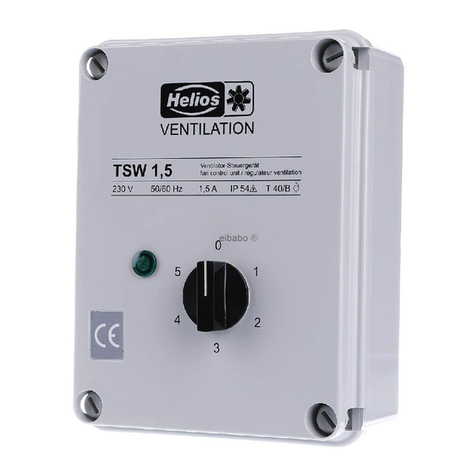
Helios
Helios TSD 0,8 Installation and operating instructions

JLCooper Electronics
JLCooper Electronics SloMoPro user manual

Moons'
Moons' LIN ENGINEERING Silverpak 17C user manual
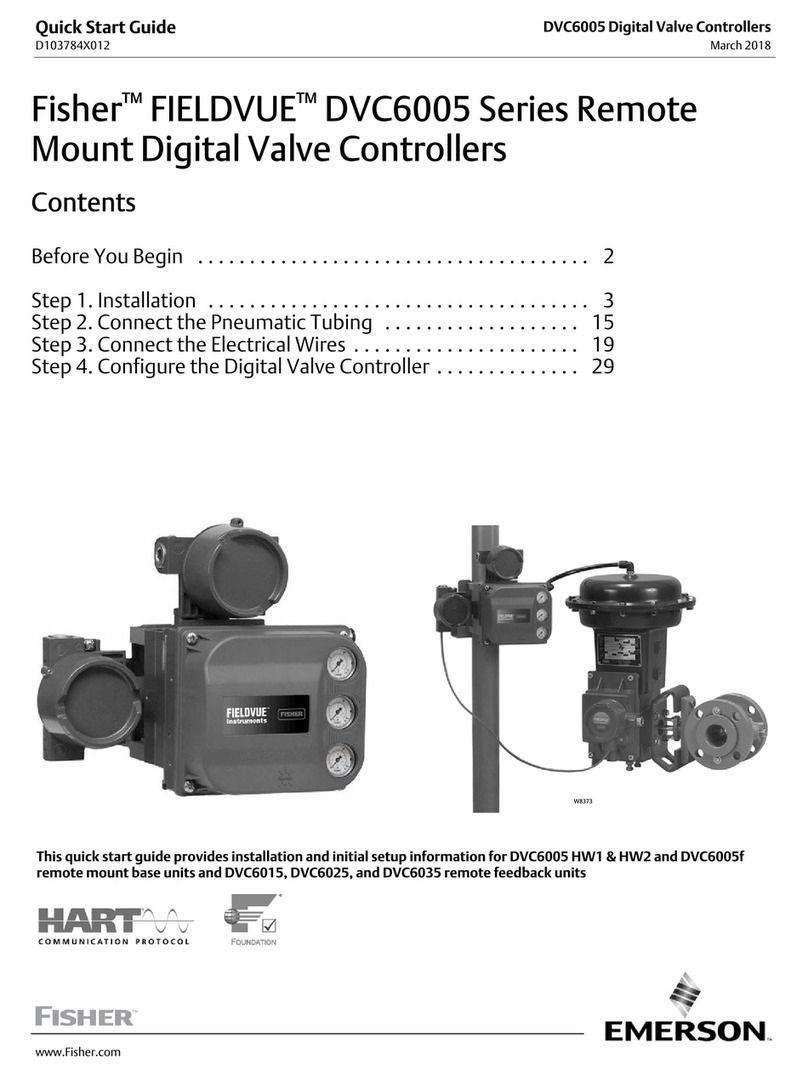
Emerson
Emerson Fisher FIELDVUE DVC6005 Series quick start guide

LEAMING INDUSTRIES
LEAMING INDUSTRIES AGC-100 Instruction book
